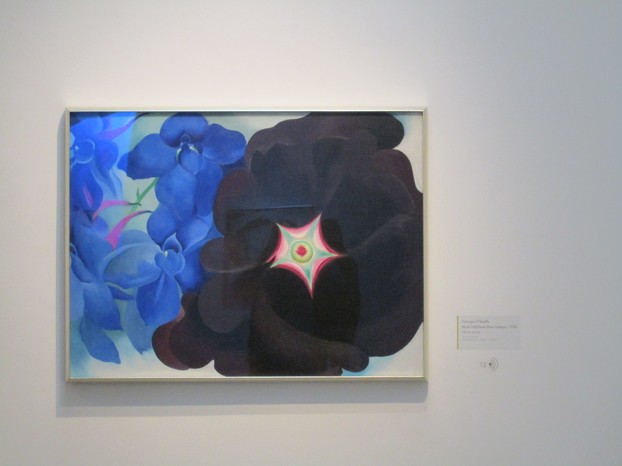Two New Mexico icons, Georgia O'Keeffe and hollyhocks, come together.
"Black Hollyhock Blue Larkspur 1930"; oil on canvas by one of New Mexico's most famous resident artists, Georgia O'Keeffe (November 15, 1887 – March 6, 1986)
Georgia O'Keeffe Museum, 217 Johnson Street, downtown Santa Fe, north central New Mexico: jaygannett, CC BY SA 2.0, via Flickr @ https://www.flickr.com/photos/29531805@N07/45493331575/
In "How Hollyhocks Came to New Mexico," because of a near-sighted angel's confusion of New Mexico for Egypt, the Holy Family journey through the spectacular landscape of New Mexico's white sand dunes.
White Sands National Monument, south central New Mexico: snowpeak, CC BY 2.0, via Wikimedia Commons @ https://commons.wikimedia.org/wiki/File:White_sands_moon_&_clouds.jpg; John Fowler (snowpeak), CC BY 2.0, via Flickr @ https://www.flickr.com/photos/snowpeak/4315626457/
Because of Sueño's near-sightedness, the Holy Family take a wrong turn in their Flight into Egypt, ending up in New Mexico's enchanting landscape, including iconic cottonwood trees.
"Pedernal"; 1941-1942 oil on canvas by Georgia O'Keefe (November 15, 1887 – March 6, 1986)
Georgia O'Keeffe Museum, Santa Fe, north central New Mexico: Ron Cogswell, CC BY 2.0, via Flickr @ https://www.flickr.com/photos/22711505@N05/10212289645/
Joseph's floral epiphanies include flowers blooming from his staff during marriage petition to high priest according to apocryphal sources and hollyhocks surfacing from ladder to Heaven anchored at base by his staff in "How Hollyhocks Came to New Mexico."
Latin American portrayal of St. Joseph as a young man, with flower-blooming staff
Oratory of the Hospital Universitario Austral, Pilar Partido, northern Greater Buenos Aires, southeastern Argentina: Gabriel Sozzi, CC BY SA 4.0, via Wikimedia Commons @ https://commons.wikimedia.org/wiki/File:St_Joseph,_portrayed_as_a_young_man.JPG












 Are Hawaiian Huakai Po Nightmarchers Avenging Halloween Thursday?on 10/02/2024
Are Hawaiian Huakai Po Nightmarchers Avenging Halloween Thursday?on 10/02/2024
 Mailing Addresses for 2023 Form 4868 Extending 1040 and 1040SR April 15, 2024, Due Dateon 04/15/2024
Mailing Addresses for 2023 Form 4868 Extending 1040 and 1040SR April 15, 2024, Due Dateon 04/15/2024
 Mailing Addresses for 2023 Forms 1040 and 1040SR Filed in 2024on 04/15/2024
Mailing Addresses for 2023 Forms 1040 and 1040SR Filed in 2024on 04/15/2024
 Mailing Addresses for 2022 Form 4868 Extending 1040 and 1040SR April 18, 2023, Due Dateon 04/13/2023
Mailing Addresses for 2022 Form 4868 Extending 1040 and 1040SR April 18, 2023, Due Dateon 04/13/2023



Comments